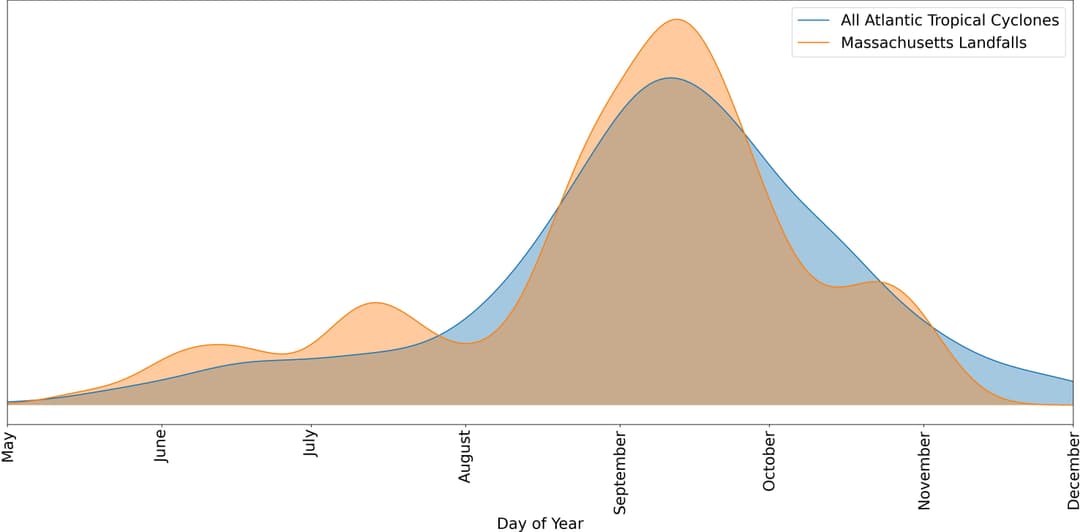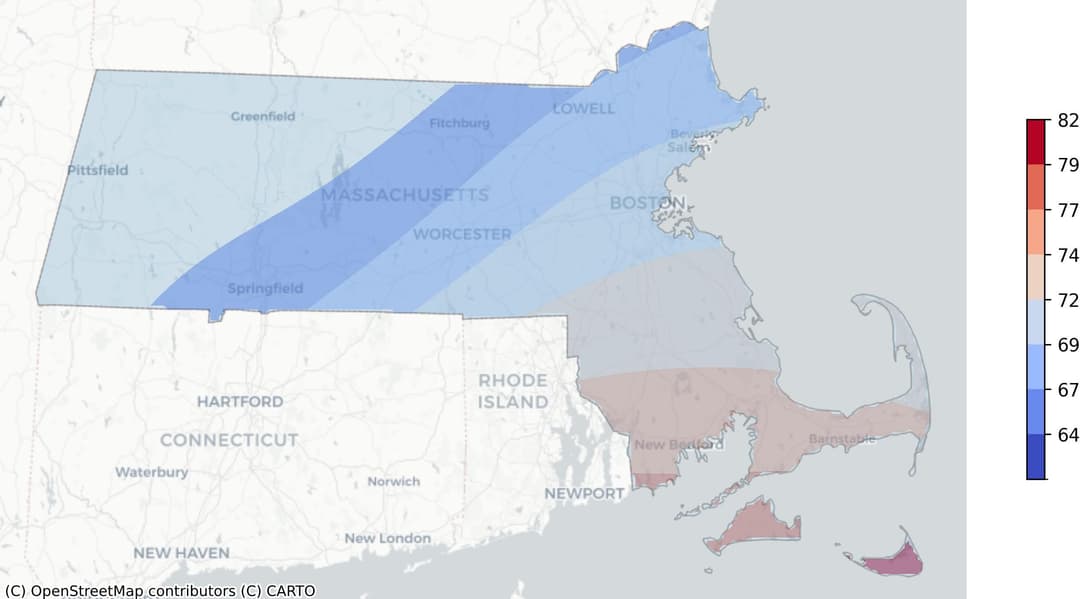Hurricanes in Massachusetts
When is Hurricane Season in Massachusetts?
Massachusetts’ hurricane season officially runs from June 1 through November 30. During this period, the state experiences weather phenomena ranging from tropical depressions to major hurricanes.
Massachusetts is not as prone to hurricanes as some other states, especially those along the Gulf Coast and southeastern Atlantic Coast. Nonetheless, the Bay State has experienced some significant hurricanes. For instance, in 1938, the Great New England hurricane, one of the deadliest hurricanes in New England history, made landfall in Massachusetts.
A comprehensive understanding of hurricane patterns in Massachusetts can be derived from the image below.
Constructed using raw data from the NOAA Hurricane Research Division, it compares actual storm landfalls in Massachusetts with the storm pattern in the entire Atlantic basin.

Where Do Hurricanes Hit Most in Massachusetts?
In the state of Massachusetts, the shorelines in Buzzards Bay, as well as along the south shore of Cape Cod, Martha's Vineyard, and Nantucket, are particularly susceptible to storm surge and hurricane force winds. This is due to their coastal locations and geographical features.
Storm surges are an abnormal rise of water generated by a storm, over and above the predicted astronomical tides.
Hurricane-force winds, on the other hand, can reach speeds of 74 to 90 mph with gusts up to 110 mph, causing widespread damage and destruction of mobile homes.
The Hurricane Risk Graph provides a visual representation of the hurricane risk in Massachusetts.

The heatmap defined by the frequency of occurrence of hurricanes weighted by wind speed. The color map ranges from blue to red, with blue indicating areas of lower risk and red indicating areas of higher risk.
What Are the Recent Hurricanes in Massachusetts?
- Hurricane Dorian (September 2019): Although Massachusetts was not directly hit by Hurricane Dorian, the state experienced significant rainfall and high winds. The storm caused minor property damage, but no fatalities were reported. Coastal areas, particularly Cape Cod, were most affected.
- Hurricane Jose (September 2017): Hurricane Jose brought heavy rain and gusty winds to Massachusetts, resulting in power outages and minor property damage. The storm's effects were primarily felt in the southeastern part of the state, including Cape Cod and the Islands.
- Hurricane Sandy (October 2012): Known as "Superstorm Sandy," this hurricane caused significant damage in Massachusetts. The state experienced storm surge, high winds, and heavy rain, leading to widespread power outages and property damage. The storm was responsible for one death in the state. Coastal communities, including Boston and the North Shore, were heavily impacted.
- Hurricane Irene (August 2011): Irene caused widespread damage in Massachusetts, with heavy rain leading to significant flooding. The storm resulted in one fatality in the state and caused extensive property damage. Western and central Massachusetts were the most affected.
- Hurricane Earl (September 2010): While Massachusetts was largely spared from the full force of Hurricane Earl, the state did experience heavy rain and gusty winds, particularly on Cape Cod and the Islands. The storm caused minor property damage, but no fatalities were reported.
How to Prepare for a Hurricane Season in Massachusetts
Preparing for a storm, particularly a hurricane, is crucial for ensuring personal safety and mitigating property damage. As hurricanes are accompanied by heavy rains, high winds, and flooding, unpreparedness can lead to serious consequences.Before a Hurricane
When it comes to hurricane preparedness, a well-organized approach is crucial. Here's a brief hurricane preparation checklist that can help you secure your safety:
- Start by developing an evacuation plan. Identify the nearest safe locations and plan your route.
- Prepare a disaster supply kit. Include essentials such as non-perishable food, water, medication, and important documents.
- Safeguard your home. Install storm shutters, secure loose objects, and clear rain gutters.
- Review your insurance policies to ensure they cover potential hurricane damages.
- Stay informed about the weather updates and heed the advice of local authorities. This step is pivotal for hurricane safety.
- Charge your electronic devices and keep spare batteries and power banks ready.
- If you have pets, make arrangements for their safety too.
During a Hurricane
When a hurricane hits, it's critical to take immediate action to ensure safety. The following are some general guidelines on what to do during a hurricane:
- Seek shelter: Look for a secure structure, ideally one that is hurricane-resistant. If you're at home, move to the part of the house that's least likely to be hit by falling debris.
- Listen to authorities: Follow evacuation orders, and pay attention to updates from local weather and emergency services.
- Avoid flooded areas: Don't attempt to drive or walk through flooded streets, as floodwaters can rise rapidly and be deeper than they appear.
- Stay away from windows: Flying debris can shatter windows. Close all window blinds or curtains to prevent injury from broken glass.
- Stock up on supplies: Make sure you have enough food, water, and medication to last for at least a week. Battery-operated radios, flashlights, and spare batteries are also essential.
- Protect important documents: Keep important documents like passports, driver's licenses, and insurance policies in a waterproof container.
- Be prepared for power outages: Have alternative ways to charge your devices. Keep a list of emergency numbers in case you can't access them digitally.
Following these steps can help reduce the risk of harm during a hurricane.
After a Hurricane
What to do after a hurricane is often a daunting task, but the first step is to ensure personal safety. Check on family members and neighbors to make sure everyone is safe and unharmed.
After confirming everyone's safety, assess the property damage. Document the state of your home and belongings with photographs or videos. This documentation will be crucial when filing your insurance claim.
Reach out to your insurance company to report the damages. For home insurance, contact your homeowners' insurance provider. If your vehicle was damaged, contact your car insurance company for a car insurance claim payout. Be ready to provide the documentation you've collected.
In the case of severe property damage, it might be necessary to find temporary housing. This could be a hotel, shelter, or a friend's home.
If the hurricane was particularly destructive, the Federal Emergency Management Agency (FEMA) may declare the area a disaster zone. If this happens, you may be eligible for federal assistance. Visit the FEMA website or call their helpline to find out more about the available assistance programs.